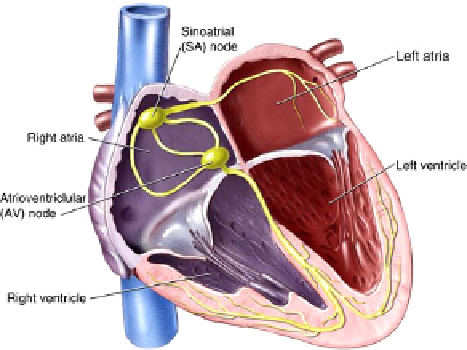Biomedical Engineering Reference
In-Depth Information
Fig. 9.1
Heart or natural
pacemaker
The pacemaker system is a small electronic device that helps the heart to maintain
the regular heart beat. In this study, the pacemaker is treated as an embedded system
operating in an environment containing the heart. We first review the heart system
that interact with the pacemaker (Sect.
9.2.1
) and then consider elements of the
pacemaker system itself (Sect.
9.2.2
).
9.2.1 The Heart System
The human heart is wondrous in its ability to pump blood to the circulatory system
continuously throughout a lifetime. The heart consists of four chambers: right atrial,
right ventricle, left atrial and left ventricle, which contract and relax periodically.
Atria form one unit and ventricles form another. The heart's mechanical system (the
pump) requires at the very least impulses from the electrical system. An electrical
stimulus is generated by the sinus node (see Fig.
9.1
1
), which is a small mass of
specialised tissue located in the right atrium of the heart. This electrical stimulus
travels down through the conduction pathways and causes the heart's lower cham-
bers to contract and pump out blood. The right and left atrial are stimulated first and
contract for a short period of time before the right and left ventricles. Each contrac-
tion of the ventricles represents one heartbeat. The atria contract for a fraction of
a second before the ventricles, so their blood empties into the ventricles before the
ventricles contract.
An artificial pacemaker is implanted to assist the heart in case of an arrhythmias
condition to control the heart rate [
39
]. Arrhythmias are due to the cardiac problems
producing abnormal heart rhythms. In general, arrhythmias reduce hemodynamic
performance, including situations where the heart's natural pacemaker develops an
1
Heart image is taken from
http://media.summitmedicalgroup.com/media/db/relayhealth-images/


Search WWH ::

Custom Search